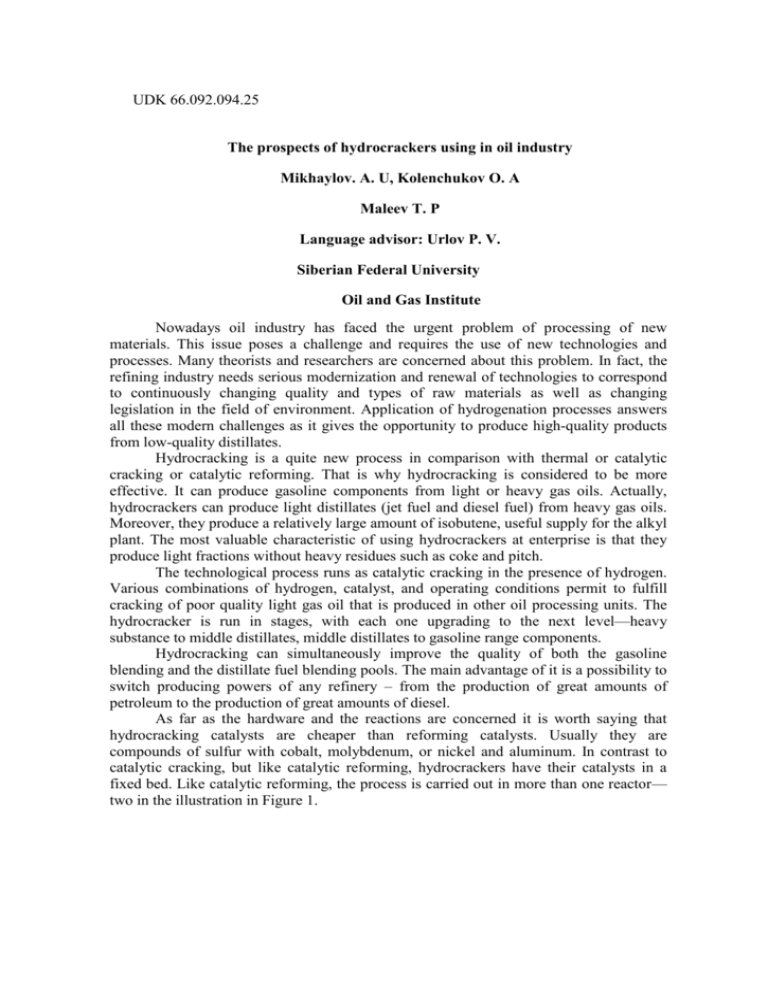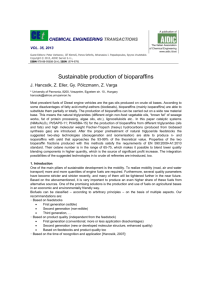The prospects of hydrocrackers using in oil industry
advertisement

UDK 66.092.094.25 The prospects of hydrocrackers using in oil industry Mikhaylov. A. U, Kolenchukov O. A Мaleev T. P Language advisor: Urlov P. V. Siberian Federal University Oil and Gas Institute Nowadays oil industry has faced the urgent problem of processing of new materials. This issue poses a challenge and requires the use of new technologies and processes. Many theorists and researchers are concerned about this problem. In fact, the refining industry needs serious modernization and renewal of technologies to correspond to continuously changing quality and types of raw materials as well as changing legislation in the field of environment. Application of hydrogenation processes answers all these modern challenges as it gives the opportunity to produce high-quality products from low-quality distillates. Hydrocracking is a quite new process in comparison with thermal or catalytic cracking or catalytic reforming. That is why hydrocracking is considered to be more effective. It can produce gasoline components from light or heavy gas oils. Actually, hydrocrackers can produce light distillates (jet fuel and diesel fuel) from heavy gas oils. Moreover, they produce a relatively large amount of isobutene, useful supply for the alkyl plant. The most valuable characteristic of using hydrocrackers at enterprise is that they produce light fractions without heavy residues such as coke and pitch. The technological process runs as catalytic cracking in the presence of hydrogen. Various combinations of hydrogen, catalyst, and operating conditions permit to fulfill cracking of poor quality light gas oil that is produced in other oil processing units. The hydrocracker is run in stages, with each one upgrading to the next level—heavy substance to middle distillates, middle distillates to gasoline range components. Hydrocracking can simultaneously improve the quality of both the gasoline blending and the distillate fuel blending pools. The main advantage of it is a possibility to switch producing powers of any refinery – from the production of great amounts of petroleum to the production of great amounts of diesel. As far as the hardware and the reactions are concerned it is worth saying that hydrocracking catalysts are cheaper than reforming catalysts. Usually they are compounds of sulfur with cobalt, molybdenum, or nickel and aluminum. In contrast to catalytic cracking, but like catalytic reforming, hydrocrackers have their catalysts in a fixed bed. Like catalytic reforming, the process is carried out in more than one reactor— two in the illustration in Figure 1. Crude, in this case heavy gas oil, is mixed with hydrogen vapor, heated to 290400°C, pressurized to 1200-2000 atmospheres, and charged to the first stage reactor. As it passes through the catalyst, about 40-50% of the feed is cracked to gasoline range material (below 200°C end point). The hydrogen and the catalyst are complementary in several ways. First, the catalyst causes long chain molecules to crack and the rings in aromatic compounds to open. Both these reactions need heat to keep them going. They are both an endothermic process. On the other hand, as the cracking takes place, the excess hydrogen floating around saturates (fills out) the molecules, a process that gives off heat. This process, called hydrogenation, is exothermic. Thus, hydrogenation gives off the heat necessary to keep the cracking and ring opening going. The catalyst and hydrogen also complement each other in the formation of isoparaffins. Cracking forms olefins, which could join together to form normal paraffins. Hydrogenation rapidly fills out all the double bonds, often forming isoparaffins, preventing reversion to less desirable molecules. (Isoparaffins have higher octane numbers than normal paraffins.) After the hydrocarbon leaves the first stage, it is cooled so most of the hydrocarbon liquefies. In the hydrogen separator the hydrogen is split out for recycle to the feed. The liquid is charged to a fractionator. Whatever products are desired (gasoline components, jet fuel, and gas oil), the fractionator cuts them out of the first stage reactor effluent, leaving a bottoms stream ready for the next, second stage, reactor. In other words, kerosene range and light gas oil range material could be taken as separate side draw products from the fractionator, or could be included in the fractionator bottoms if further conversion to gasoline range material is the object. The stream is again mixed with a hydrogen stream and charged to the second stage. Since this material has already been subjected to some hydrogenation, cracking, and reforming in the first stage, the operations of the second stage are more severe (higher temperatures and pressures). Like the products of the first stage, the second stage product is separated from the hydrogen and charged to the fractionator. Some hydrocrackers are configured in three stages, either by stacking different catalysts in one reactor or by having three reactors. Different reactions take place in each stage. In the first stage, the catalyst opens up the rings of complicated molecules where the contaminates, sulfur and nitrogen, might be embedded. The hydrogen forms hydrogen sulfide (H2S) and ammonia (NH4). At the same time the hydrogen fills out many of the opened double bonds, forming simpler, lighter compounds. In the second stage, run more severely, the catalyst opens more rings of the heavy, complicated molecules and cracks others, forming light products. In the third stage, a kind of polishing job takes place where the olefins and aromatic compounds are saturated, forming naphthenes, paraffins, and especially isoparaffins. Taking everything into account it is worth saying that though being expensive to install hydrocracking compensates all the expenses and turns out to be very profitable. Hydrocrackers allows to produce higher quality gasoline in a cheaper way. And finally one more important advantage is low cost catalysts which are used in the installation. References 1. Akhmetov, SA, deep oil refining technology. St. Petersburg: Nedra, 2007. 2. Kramer, LM Hudaydatova, LB, deeper processing of stable gas condensate at Astrakhan GPP. - 2000. 3. Sardanashvily AG, Lviv AI Examples and problems on the technology of oil and gas. - M: Chemistry, 1973. 4. Tanatarov MA, Racine MG, Process calculations refining plants. 1987 5. Erich VN Rudin MG Chemicals and Oil & Gas Technology. - A: Chemistry. 1985.











